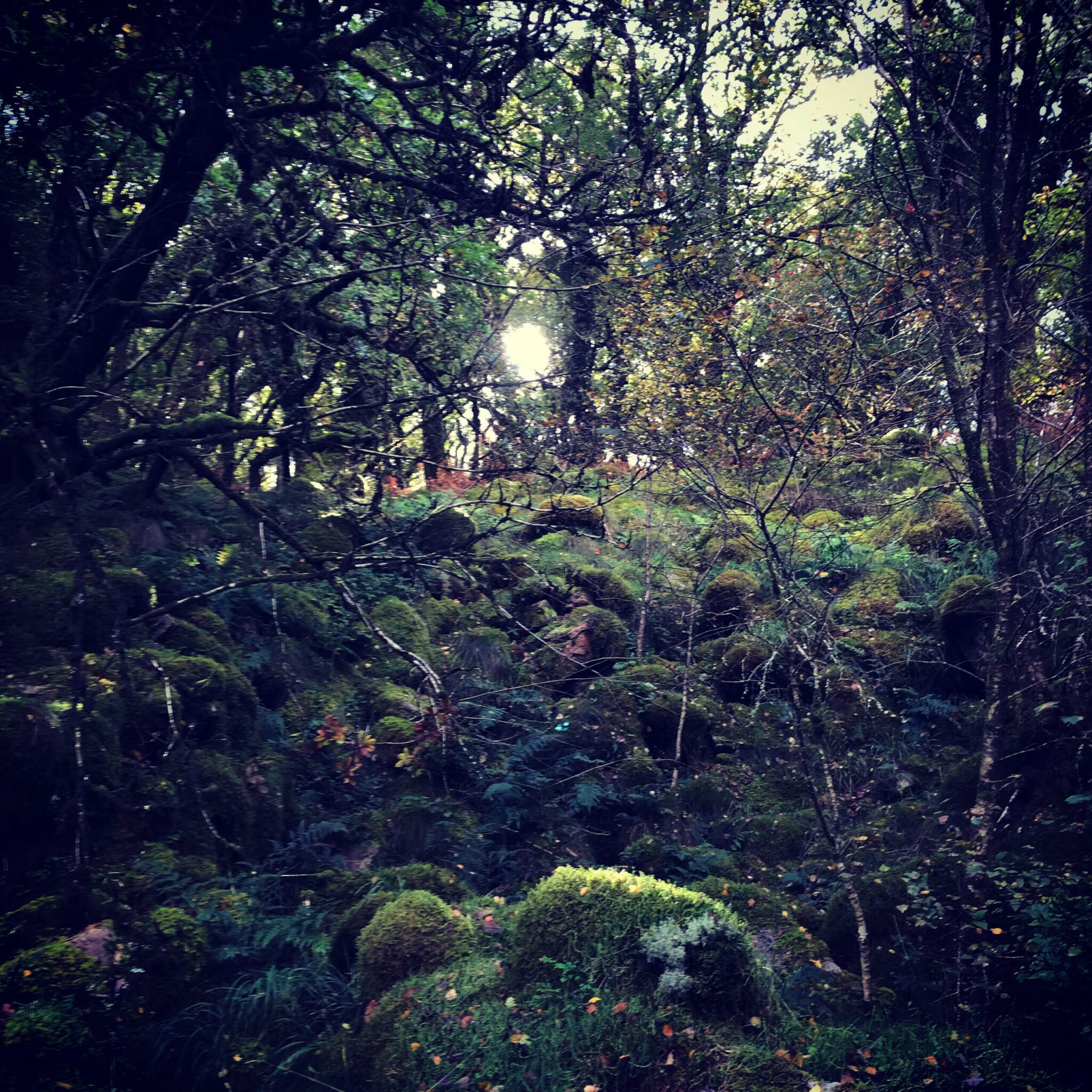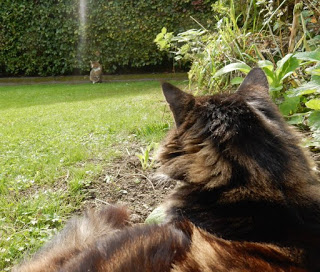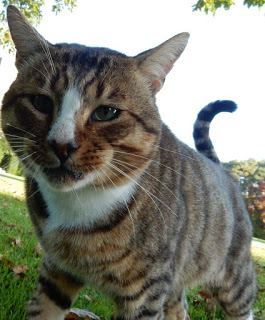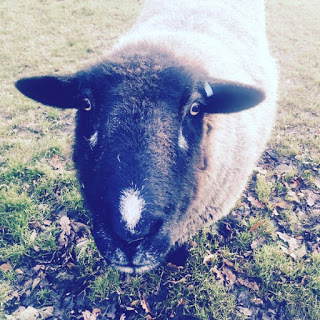I was trying unsuccessfully to find some picture hooks so I thought I’d have a look in a drawer in my garage. I’d not been in there for several weeks and, by opening the door, I managed to disturb a sleeping cat. I’m not sure who was more surprised: me, or the sleeping cat. We both did a little jump and the cat escaped through a hole in the back wall. I hadn’t been aware that my garage had a hole in its back wall, nor that it had a cat living in it, and both these things made me think I should make an effort to get to know my garage better.
The cat wasn’t one of mine but a chunky tabby stray with a vertical war paint stripe on his nose who’s been hanging around my garden and the countryside surrounding it since late August, spitting cusswords at my three male cats and periodically trying to bang the female one. At first I’d assumed, going on his tumble dryer-soft fur and athletic good looks, that he was what feline enthusiasts tentatively call “owned” but time has proved otherwise: none of my neighbours know who he is and, as the weeks have passed, his 3am meowing sessions outside my bedroom window have become more keening and forlorn. He was almost approachable when I first met him but, having mistaken him for a spoilt thug, I chased him off a few times, waving the bill for the damage he’d caused to the nose of my own tabby, Ralph. Since then, he’s become less amenable but no less ubiquitous. I feel bad, and I’d like to catch him and find out if he’s microchipped, but I don’t want another cat. I never really intended to have four in the first place. All that happened was that over a period of years various ones kept looking at me in a sweet way that made me let my guard down and, before I knew it, there they were, permanently in amongst my knitwear and clean bedding, shitting it up in their multifarious ways.

You can live a relatively lavish life in summer and autumn in our somewhat utopian part of rural Devon if you’re a stray cat with a modicum of resourcefulness. After you’ve picked off one of the endless supply of unuspecting local rabbits you can wash its innards down with some fresh stream water then conk out for a few hours under a hibiscus while a person clad in sackcloth soothes you to sleep with their weekly flute practice. But I’ve worried about my feline intruder recently, as the temperature has dropped and the wind has raged, and I’m glad he has found a sheltered place to sleep, amongst my rusting golf clubs and old magazines.

The wind talks the big talk in Devon but, when you compare it to the kind you get on the east coast, it’s got false teeth. Even at its worst, it never makes your eyes, cheeks and chin sting in that way a winter wind in Norfolk or Lincolnshire will. That said, it’s been blowing with the breath of a hundred-headed Celtic demon recently, making me feel, at night, like I’m barricaded in my house in some zombie film where leaves play the traditional role of zombies. Branches tap furiously on my dark office window as I write and the thick granite walls of my draughty single-glazed hilltop house seem to be all that’s stopping it from being whipped up from its foundation and over the valley towards Newton Abbot. In the midst of this cacophony, a small alien meow can have the effect of a little man sitting in your ear, playing the one of history’s saddest melodies on the world’s smallest harp.
On the morning I discovered the stray cat – let’s call him Uncle Fuckykins, because I want to and, since he’s unlikely to ever be mine, probably won’t be forced live with the consequences – the wind was at its most heinous. It was the kind of wind that makes you feel slightly undignified just by standing in it, as if you’ve neglected to put on a socially crucial item of clothing and are hoping nobody you admire sees you. Only a total idiot would spend any time out in it that wasn’t totally necessary. So, having left a bowl of food in the garage for Uncle Fuckykins, I got in the car, collected my friend’s dog, Billy, and went for an eight and a half mile walk on a particularly exposed part of the moor. I’d read a bit about this region of the moor the night before in a 19th Century book. “This area is sometimes referred to as ‘The Valley Of The Thunderstorms’,” it announced. “Cool,” I thought. “Let’s go.”
Dartmoor is the lone place in Devon where the bite of the wind can match its eastern counterpart. As I climbed from a logan called, wonderfully, The Nutcracker to the summit of Rippon Tor, the breeze spun me in a quarter-circle and turned my hair into old useless bindweed. Beside me, Billy sulked slightly, having been put on his lead for the benefit of sixteen semi-wild cattle. Once we were over the brow of the tor I threw a stick to appease him. He fetched it, then guarded it jealously from me, as he always does. I am seldom in the habit of putting wood between my teeth and have never given him any concrete reason to believe that I would steal one of his sticks but, even after knowing me for a year and a half, he remains suspicious of my motives when he has one in his mouth. Billy is a black dog, which is apt in this terrain of demon hound legends, but ghoulishness is not really his area of expertise. A toy-miniature poodle cross, he is scarcely bigger than Uncle Fuckykins and possibly a degree smaller when his black curls are slicked down with upland rain. His owner, Susie, has recently had a terrible infestation of rats, who have chewed through the bathroom pipes and electrical cables in her moorside cottage. A few weeks ago she entered her kitchen and an especially big one ran straight at her. “I jumped on a chair and screamed,” she told me. “I was hoping Billy might come to my rescue but he just jumped on the chair with me and started screaming too.”
As my borrowed black dog and I turned west for Top Tor and Pil Tor, I mentally listed the possible dark and mysterious moorland legends he might inspire. The best I could come up with were the following:
1. The dark and mysterious legend of how he ran after a cyclist on a path near Ivybridge but then got spooked by some rainbow jumper hippie kids listening to dubstep in some trees.
2. The dark and mysterious legend of how he ran off down a deep ravine near Venford Reservoir, yip-squeaking, after seeing what he thought was a sheep and didn’t come back for thirteen minutes.
3. The dark and mysterious legend of how a post office receipt fell out of my wallet and he ran off with it then barked and chewed it when I ran after him and asked for it back.
4. The dark and mysterious legend of how he weaved through the legs of three cows in a water meadow, like a tiny dickhead.
5. The dark and mysterious legend of how he ran after a black labrador into a river then thought better of it.
6. The dark and mysterious legend of how he got miffed with me when I dropped him off at home an hour earlier than promised.
Above us, further west, a celestial hole opened up in the clouds, shooting rays down over the stone rows of Fernworthy Forest: as good a spot for an alien landing as there could be in England. In the valley below, just over a mile away, I spotted the unusually tall, damaged spire of Widecombe church and abandoned my route to turn half right towards it, remembering the story my friend Mike, a veteran member of the Dartmoor Rescue Team, had told me about Jan Reynolds selling his soul to the Devil there in the autumn of 1638. This was the cool thing about selling your soul to the Devil in the 17th Century: you’d invariably have to go to a tract of bleak and windswept land to do it properly. Nowadays you can do it all from the comfort of your own home, just by running a property developing enterprise or writing some confessional journalism for The Daily Mail. The Reynolds story is a West Country equivalent of the legend of Black Shuck and Blythburgh’s Cathedral Of The Marshes: a real-life, violent storm causing damage to the house of god and being blamed on demonic activity in popular folklore. This time the damage was not caused by a black dog, though, but by the Devil and his supernatural flying horse, who wrecked the church during their journey to claim the soul of Reynolds, a well-known local gambler and church-dodger. As Reynolds was carried off over Birch Tor, he dropped the playing cards he’d been holding, which allegedly left giant imprints on the moor in the shape of the symbols on the cards. Mike has been on the Dartmoor rescue team for a long time but it should be pointed out that it is not long enough to have been involved in the attempt to rescue Reynolds and his horse from the Devil.
Widecombe-in-the-Moor is also famous for the folk song Widecombe Fair, which is also horse-themed: a tale of a horse theft in the area, along with a list of people going to the fair in question. A strong argument could be made against the necessity of the list’s length. The classical-influenced psychedelic folk band Renaissance did a great version of Widecombe Fair – using its old name, “Widdicombe” – in 1971 but essentially the song is a bit like an old time folk version of one of those tedious conversations you overhear on a train sometimes, where a young man is speaking into his mobile phone and listing all the people he has secured to join him for a night out (“Tom Cobley’s confirmed now, too! It’s going to be sick!”). Behind me where I sat and ate some chips in Widecombe’s extremely welcoming Rugglestone Inn were some original 1800s illustrations detailing events at the fair. They were very nice, although conveyed a strong ambience of “several people probably sneaking off to shag people they shouldn’t while festivities take place”.
While I ate my chips, I read a little more about Widecombe in Sabine Baring-Gould’s collection of Dartmoor essays, A Book About Dartmoor. It could be argued that the title of this, too, is somewhat overlong, and a simple “Dartmoor” would have sufficed. Nonetheless, I decided to let that go when I bought it, as the Totnes branch of Scope only wanted £2.50 for it. Baring-Gould describes Widecombe as a village “walled off from the world”. But when I climbed one of these steep green walls twenty minutes later all I could see was that hole in the sky and, beneath it, heather, dead bracken, tussocky grass and large prehistoric boulders: a debatable definition of “world” but one I am very comfortable with. My great-grandma and her parents lived a few miles north of here, near Princetown, in the late 1800s where, as tenant farmers, they provided food for Dartmoor Prison. When they moved to Nottinghamshire, in the early part of the next century, her mum caused a great stir by being the only woman in the neighbourhood who went to the pub on her own. I like to tell myself that this is why I feel so utterly at home on the moor: because I am descended from these progressive Devon folk who, before they were farmers, were probably shit hot cool druids or witches or something. More likely it is actually because I love the moor’s air, its diversity of landscape (when the Chinese public were asked to come up with a new name for Dartmoor they chose one whose translation is “Multiple Beauty”), the antithetical escape it gives me from the bullying demands of technology, the way its weather beats me up, the space it permits stories and legends to grow.
There is room to imagine so much into existence here. Climbing to the top of Buckland Beacon, beside a dog apparently made entirely out of knitting materials, with that glowing crack in the clouds above and not another human in sight, it was not hard to look back and picture woolly rhino and mammoths trudging across the valley below. I like, in fact, to imagine that there was a time when all animals were woolly.
“That snake over there looks exceptionally warm.”
“Yes. That’s because it’s a woolly snake.”
The colour of the dusk as the walk ended reminded me of the dusk in An American Werewolf In London when David and Jack come down off the moor to visit The Slaughtered Lamb pub in East Proctor. As 14 year-old, I recorded some evening golf highlights on BBC2 and let the VHS tape run on so it also recorded the first 35 minutes of the film when Alex Cox showed it on Moviedrome. Over the next year I must have watched those 35 minutes two dozen times, learned them off by heart. When I finally saw the rest of the film, a few years later, I felt let down by its cartoonish gorefest. I like my horror to be about the power of suggestion, not blood. This is another factor behind my love of the moor.
I amped up that power of suggestion on the way back to the car by ignoring the classic American Werewolf advice to stick to the path. In all honesty, it wasn’t the most swashbuckling move, as I remained very aware of where the path was the entire time. Every bit of me up to shoulder height, and quite probably beyond, was mud-spattered, but that had been very much part of the plan at the day’s beginning. Where is the pleasure in being clean if you have never got dirty?
A lone set of headlights winked around Rippon Tor in the distance and the temperature underwent a violent drop that felt like a small old cushion being pulled from beneath me. We’d done eight and a half miles, my hip clicked, my calves ached and Billy limped a little on his back left side. Tiredly we jumped puddles of peaty water. Multiple gorse perforations incurred on the climb to Buckland Beacon gave me shin burn. Half an hour earlier I had been stroking the head of a cheerful storybook sheep in daylight. Now it was abruptly apparent that this upland was not just the setting for the unwritten ghost stories in my head; it was a place where, if you were tired enough and cold enough and lost enough, you would probably not take long to die. I was glad to reach the car, to drop Billy off at home, and to fantasise about the hot bath I’d soon plunge into. I nagged myself into making a quick stop at the supermarket on the way home: partly for me, but primarily to get my cats some food of a slightly better quality than normal, due to the stab of guilt I felt for feeding theirs to Uncle Fuckykins. If this was to be a regular event, some prandial hierarchy needed to be imposed. I checked my phone: there was a message from my dad, who’d found out I was walking today, and wanted to tell me “NOT TO STAND ON TOP OF ANY CLIFFS IN THE WIND” and to “WOFFAL”. The latter is his recent, time-saving abbreviation of some advice he has given me every time he has seen me for as long as I can remember: “WATCH OUT FOR FOOKWITS AND LOONIES!” I returned the phone to my bag. In front of me in the queue, a woman purchased a jet black eel, wrapped in clingfilm. I was not aware that any supermarket fish counter sold a creature of such size. It was without doubt longer than my arm and probably thicker. I felt very unadventurous, with my blueberries, my fake milk and my block of mature cheddar. “Wow!” said the checkout operator. “Is it the cat’s birthday?” The woman told him that it wasn’t.

Read more about Billy in my latest book.











Excellent. I love the idea of a knitted Billy!
Uncle F looks a right bruiser but I'm glad he's found a friend . Loved this piece. I had to look quite hard at the picture of Billy to work out which end I was looking at. Must say he's a stoical dog. Whenever i've walked on hills and high places I've always felt a sense of being watched. I just think it's the land, alive and breathing and watchful .
"–yip-sqeaking after a sound he thought was a sheep" That's one part I like about your writing. Languages, sounds, scents, breathing in, wishing for more & more.
I too wish that my ancestors had been "shit hot cool druids or witches." I am mostly Irish after all. I love the way you not only describe the area, but give it such an other-worldly, supernatural air.
Peg
I wish my eye-brain connection produced such creativity… You induce such brilliant pictures in my mind that I don't really need the photographs, much as I enjoy them too. Thanks for another great piece (cheering me up greatly among the devastation that is Cumbria just now, though personally I'm fine).
Sounds like you have another cat. Watch out for the Weresheep.
Watch out for the Weresheep too. They come from space. Next time I visit Britain I will visit the Moor I think. Sounds lovely. Dangerous sheep aside.
About dogs and sticks – watch this from 4 mins 37: https://youtu.be/lnBtd-dOnUQ
All will become clear…
Too worried about the fabulous Uncle F. of the White Stripe to read about the rest. Of all the gin joints, in all the towns, in all the world, he walks into your garage. Sorry for the bad Casablanca riff but he needs your help. A trap for getting him to a vet and neutered, a warm nest in the drawer without pointy, rusty objects until then. He's an old soul with a lesson for you. You may be a temporary custodian but he's there for a reason. I'd Btw, The Good, The Bad And The Furry made my 2015 top 10 cat book list.
We have an Uncle Fuckykins too, a huge behemoth of a tabby who lurves us, lurves our house and other cats, but also like to try to procreate with every other being, no matter species or gender. (And he's fixed too, guess they left a bit behind.) I think I'll make a bracelet with WOFFAL on it, it's best to always remember that advice.
Cats, dogs,the moors and legends-what's not to love! I did a walk on the moors with some ex Dartmoor rescuers-damn they can climb a tor faster than I could zip up my waterproof! Another example of age and experience winning out!
Excellent pictures of phallic rocks and wooly animals. And, I totally understand about the cat collection. I had two female cats who were both fixed, and yet they've managed to multiply to embarrassing numbers. All fixed, and still multiplying.
I'm intrigued by the story of some Chinese people being asked to rename Dartmoor. I wonder why?